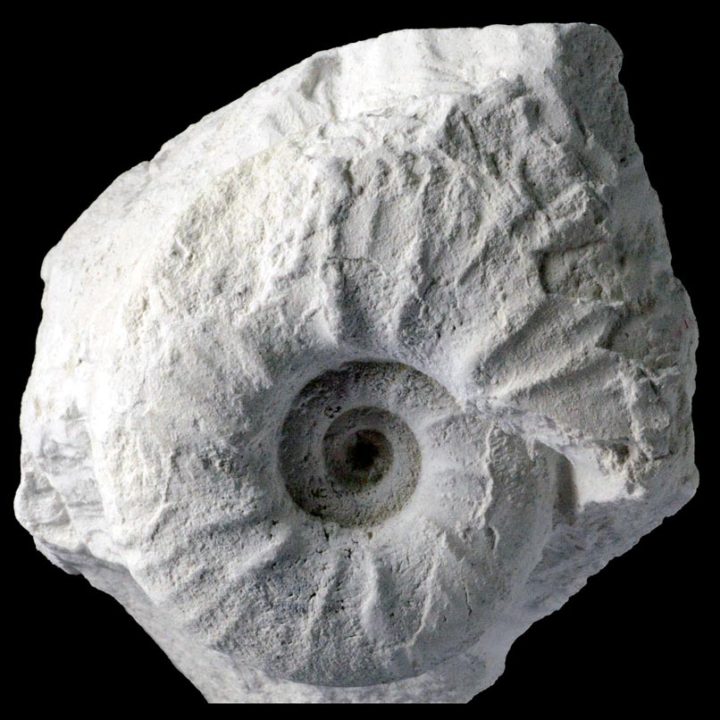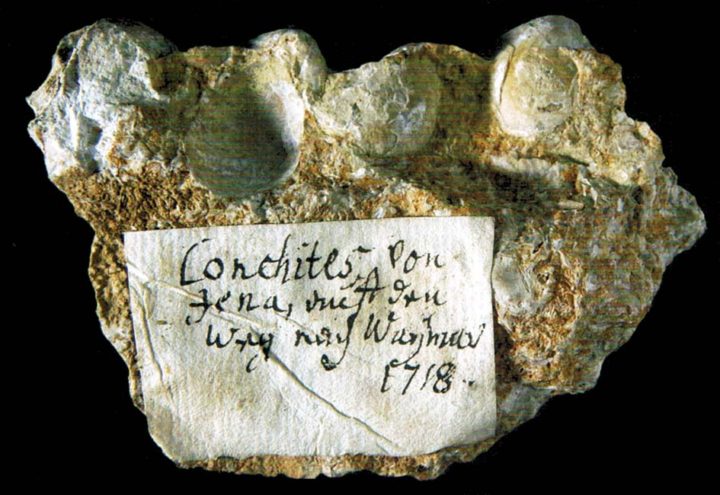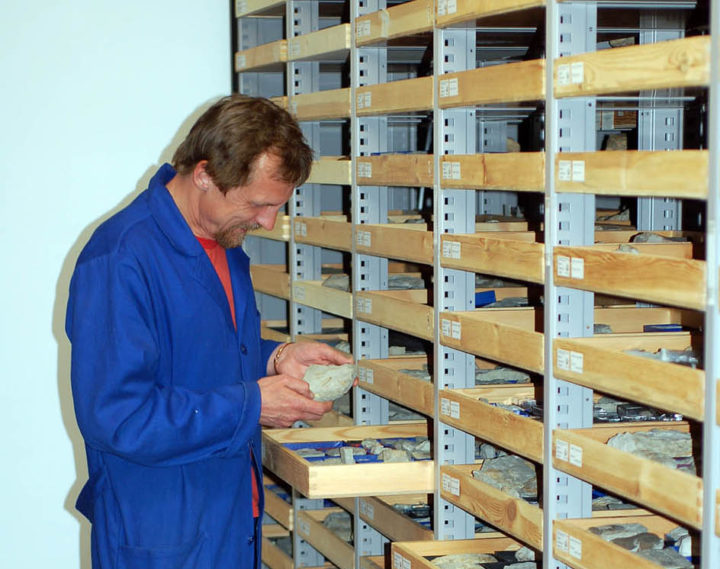Fossil Macro-invertebrates, i.e. relatively large non-vertebrate animals such as ammonoids and bivalves, are in the focus of research of the palaeozoology section of the Museum for Mineralogy and Geology of the Senckenberg Natural History Collections Dresden. Temporal focus is the Mesozoic Era (ca. 250-65 myrs before present), in particular the mid-Cretaceous epoch.
Macro-invertebrates
Based on their size and morphological characteristics, macro-invertebrates bear the invaluable advantage that they are relatively easy to identify. Furthermore, they yield important palaeo-ecological information about the distant geological past. Fossil macro-invertebrates
• reflect a large part of Earth’ palaeo-biodiversity,
• provide the best groups for high-resolution integrated biostratigraphy (i.e., relative dating of sedimentary rocks; e.g., ammonoids and inoceramid bivalves),
• have relatively well known preferences for environmental factors such as temperature and salinity (i.e., are invaluable tools in palaeo-environmental reconstructions),
• are direct witnesses and important archives of past Global Change.
Thus, fossil macro-invertebrates are invaluable tools in palaeo-environmental reconstructions. Thee analysis of fossil macro-invertebrates and their communities in time and space can be used to decipher and to evaluate past Global Change.
The Mesozoic Era
The Mesozoic Era was largely an intense greenhouse world characterized by considerably increased atmospheric CO2 levels. Marine sedimentary rocks and their fossil record are important archives of this important interval of Earth’ history. They document the evolution of comparably modern biota, long- and short-term climatic change, global catastrophes as well as intense plate tectonic activity and rapid palaeo-geographic revolutions. The integrated analysis of marine sedimentary rocks and their fossil inventories allows us to understand the function of past ecosystems under the conditions of an extreme global greenhouse climate and to track the changes of biodiversity of selected groups of organisms in space and time. Thus, the past may be the key to future global change.
The analysis and reconstruction as well as the functional understanding of complex Mesozoic ecosystems requires an inter-disciplinary approach that combines traditional palaeontology and sedimentology with modern methods such as microfacies analysis, stable isotope geochemistry, quantitative palaeo-ecology and high-resolution integrated stratigraphy. By means of several case studies from fossil shelf environments, the patterns of Mesozoic changes will be demonstrated, driving mechanisms will be outlined, and evaluated with respect to potential future Global Change.
Third-party funded research projects
DFG project WI 1743/11-1
Title: Understanding palaeoenvironmental constraints on glaucony formation – insights from Late Cretaceous greensand giants (since 11/2019)
Research Assistant (M.Sc.): Niklas Metzner
Green authigenic marine clays developed in Earth history from the late Palaeoproterozoic to the Recent with an accumulation maximum centered on the Cretaceous Period. This project aims at understanding the environmental parameters which controlled the massive formation of green marine clay minerals during the (early) Late Cretaceous (Cenomanian to Coniacian) and their accumulation to thick, widespread sequences of greensands (“greensand giants”) characterising nearshore settings in many basins worldwide. The integrated approach combines stratigraphical, sedimentological, mineralogical and geochemical analyses with the Cretaceous palaeoenvironmental/-geographical context. Regionally tied to and based on well-dated sections around the Mid-European Island, the project also challenges the geological principle of uniformitarianism positing that “the present is the key to the past”: the massive, very widespread formation and accumulation of glaucony-dominated greensands in nearshore settings is not matched by data from recent depositional systems. These observations suggest that the presence is not always the key to the past. The main goals of the project can be summarised as follows:
- to investigate stratigraphical, sedimentological and palaeogeographical conditions of greensand giants around the Mid-European Island;
- to obtain quantitative data on the rock-forming green grains (morphology, colour, abundance, mineralogy, geochemistry);
- to characterise and understand the geochemical environment of shallow-marine Late Cretaceous greensand formation;
- to test the hypothesis that widespread shallow-marine glaucony formation during the (early) Late Cretaceous is related to the chemical properties of the shallow-marine realm.
Although the research project is regionally based on sections from Germany, it deals with a global phenomenon of considerable importance that can be narrowed down and tackled well in the proposed study area: the integrated analysis and comparison of different settings around the Mid-European Island will provide clues for the formation conditions of Late Cretaceous greensand giants.
DFG Project WI 1743/8-1 (successfully concluded)
Title: Biodiversity and plankton-benthos coupling: an integrated ecosystem analysis from the Late Cretaceous Chalk
Summary: The structure of marine fossil food chains in pre-Cenozoic oceans is poorly understood due to a bias of integrated palaeobiological studies towards the reconstruction of past geological environments. Despite an often good knowledge of the taxonomic and palaeoecologic affinities of individual groups of organisms (e.g. calcareous nannofossils, foraminifera, bivalves, etc.), hardly any approaches exist which integrate quantitative and qualitative palaeobiological data from taxonomically different macro- and microfossils in order to reconstruct food chains, feeding patterns and nutrient fluxes of the past.
We aim at reconstructing the structure and composition of a Cretaceous food chain by deciphering coupling patterns of primary producers and consumers. By studying plankton and benthos from the same samples of Lower Maastrichtian Chalk, attributed to a stable oligotrophic phase, we want to answer the following questions:
a) How did the pelagic-benthic coupling and nutrient flow operate under oligotrophic conditions in a large epicontinental shelf area?
b) What are the effects of low vertical Corg fluxes for benthic associations?
c) Are minor productivity changes across orbitally forced cycles reflected by palaeontological and geochemical proxies?
d) What is the palaeoecologic and palaeooceanographic significance of specific macrofossil-rich horizons?
Ultimately, the combined data set will result in an integrated ecosystem analysis of the Late Cretaceous Chalk Sea.
DFG project WI 1743/6-1/6-2 (successfully concluded)
Title: Testing the isochrony, evaluating the temporal patterns and quantifying the rates of early Late Cretaceous sea-level changes – an integrated approach.
Summary: The warm early Late Cretaceous greenhouse epoch was characterized by generally rising or high sea-level stands repeatedly punctuated by large and rapid sea-level drops, the reasons of which are still poorly understood. Some of the sea-level falls have been speculated as glacio-eustatically driven by means of positive 18O shifts in more-or-less diagenetically unaltered foraminiferal calcite from ODP legs. However, the isotopic evidence is often ambiguous and offshore core logs and onshore sequences are still difficult to correlate. On the other hand, onshore sequences bear much more comprehensive information on, and have significant potential for unravelling the pattern of early Late Cretaceous sea-level change.
Unconformities are well expressed onshore and they can be stratigraphically calibrated by means of integrated approaches, especially high-resolution macrofossil biostratigraphy, carbon stable isotopes and cyclostratigraphy. Along with analyses of (bio-)facies and stratal architectures such as on-/offlap geometries or incision at sequence boundaries, a fairly precise assessment of the magnitudes and rates of sea-level change is possible. In order to test the isochrony of early Late Cretaceous sea-level change, an interplate sequence stratigraphic study of selected Cenomanian-Turonian (~100-90 myr) sea-level events on different tectonic plates (Europe, northern Africa, Middle East) is proposed. Furthermore, the periodicities of the sea-level changes and the role of high-frequency orbital forcing in the Milankovitch Band (<500 kyr) versus low-frequency modulation of these oszillations (>1 myr) will be estimated. This study will be a crucial test for reconstructions based on isotope proxies only, and bears important implications for both Mesozoic greenhouse climates and the evaluation of future sea-level change.
International Darius-Programme project
Title: Stratigraphy, facies development and geodynamic significance of the Cretaceous of the Yazd Block (Central Iran).
Summary: This application focusses on the mid-Cretaceous carbonate systems developing at the western margins of the Central-East Iranian Microcontinent (CEIM) in order to unravel the geodynamic backgrounds of basin formation and the origin of the major tectonic unconformities. Detailed facies analyses and an integrated stratigraphic approach combining high-resolution bio-, sequence, cyclo- and carbon stable isotope stratigraphy are used to track the temporal-spatial variability of the depositional environments. The mid-Cretaceous facies development of the CEIM, exemplified by the successions of the Yazd Block, is crucial for the understanding of the geodynamic evolution of the Iran Plate and adjoining regions.
The purpose of the proposed research is to fill the present gap of information in order to provide a more comprehensive picture of Cretaceous geodynamics in the area. Furthermore, the synchronicity of Aptian-Turonian sea-level changes will be tested by comparing the constructed regional relative curve with sequence stratigraphic charts of the Arabian Plate and European basins. Finally, the impacts of the oceanic anoxic events OAE 1a (early Aptian) and OAE 2 (Cenomanian-Turonian boundary) will be evaluated.
Additional research projects
Title: Cretaceous coastal systems exemplified by the Galala and Maghra el Hadida formations (Eastern Desert, Egypt).
Summary: Sedimentary rocks and fossils of Cretaceous coastal systems are excellent archives of past global change. At the interfaces from land to open sea they record both, terrestrial and marine signals and are characterized by great dynamism and diversity. Due to the great advances in integrated stratigraphy, these marginal systems in the geological past can now be studied with high-resolution methods, as can be demonstrated using the example of the Cenomanian and Turonian in the Eastern Desert, Egypt. The fossiliferous strata of the Galala and Maghra el Hadida formations in the Wadi Araba of the northern Eastern Desert in Egypt represent sediments that were deposited under subtropical conditions at the land-sea interface during the early Late Cretaceous Period at the southern margin of the Tethys Ocean.
Title: Macroinvertebrates of the peri-Bohemian Cretaceous.
Summary: Marine, fossiliferous sediment series were deposited during the Late Cretaceous in facies belts parallel to the coast around the Bohemian Massif as SE part of the Central European Island. Analyzes of the palaeo-biodiversity and the biofacies of the Peri-Bohemian Cretaceous are envisaged to serve as a case study for the distribution patterns of organisms depending on physico-chemical environmental factors, representing an important piece of the complex palaeo-biogeographical puzzle laid out during the Cretaceous Period.



